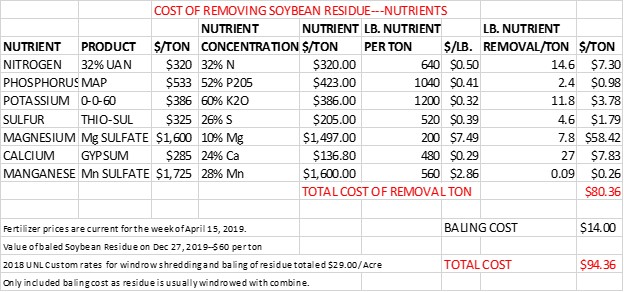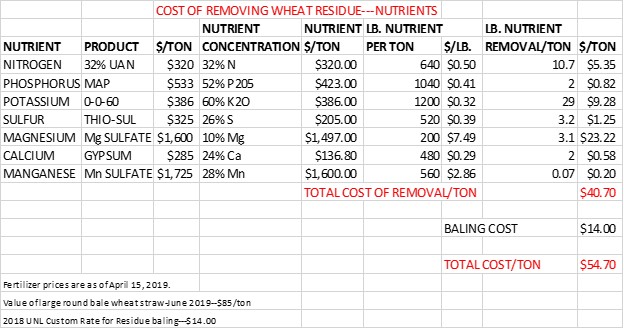In Early September, I wrote a blog post entitled The Downside of Baled Crop Residue. My previous post focused on cornstalks. After harvest, as I traveled across the state, I have observed we have more harvested crop residue to consider. Baling soybean and wheat residues are poor economic decisions and negatively impact soil health of harvested fields.
Baled Soybean Residue
About a week after my first article, I received an email from a consultant who wanted to know if I could supply a nutrient removal table for soybean residue for an end user who was talking to farmers about baling soybean stubble. Looking to the subsequent table, the economics for baled soybean residue was more negative than for cornstalks. Sulfur removed is 50% more, calcium 3 times more and magnesium is almost double that of cornstalk removal. Soybean residue barely covers the soil post-harvest and windrowing and baling virtually strips the soil of the little protective armor that was there. Based on the value of imported nutrients alone, the price the end user was offering made for a losing proposition.

Baled Wheat Straw
Wheat residue is an interesting story. As a former livestock producer, it was always useful to have some wheat straw available for bedding. At the time of this writing, the price for straw ($85/ton) is greater than the nutrient value and baling cost on a per ton basis. Many producers who use straw for bedding also haul it back out to the field. The straw now contains manure, making it nutrient rich. I do think it is very important to plant a cover crop on the wheat field immediately after baling for two reasons:
- To armor the soil
- To feed the soil biology between cash crops.
This also aids in avoiding fallow syndrome for the next year’s cash crop.
Economics of Selling Harvested Crop Residues: Is it Really Worth It?
Recently I have seen farmers selling corn residue to custom operators to be baled and sold to an end user on a contract basis. As I showed in my first article, if you bale your own cornstalks and sell at the market price of $60/ton, it results in an economic loss of $48.86/ton (Carbon value of $23.80/ton included). The custom operator buying and then selling those same cornstalks will get that same $60/ton. Do you really think that the custom operator will give all that $60/ton to the farmer with the residue? I don’t believe so. To be very honest, this practice by farmers just boggles my mind! Sadly enough, this also shows the current economic status that production agriculture is going thru right now where some farmers are grasping for ways to generate income but essentially stumbling over dollars to pick up pennies.
Negative Impacts on Soil Health
When baling corn residue, producers either use a double wheel rake or a flail shredder to windrow cornstalks. I observed raked fields left a decent amount of ground cover. However, in flail shredded fields many were shredded so aggressively that there was almost no residue except the stalk left on the field. This left soil exposed. One of the five Soil Health Principles is keep armor on the soil.
Every year I hear producers concerned about soil crusting. This is a direct result of decreased water holding capacity, which can be measured at Ward Laboratories, INC. Raindrops pound the soil, breaking down the aggregates to sand, silt and clay. Then as the soil dries, a crust is formed, making it difficult for seedlings to push their way through the hard layer. That is one reason it is important to keep either residue and/or a cover crop on the field. vegetation in the soil keeps the raindrops from impacting the soil. Essentially, plants disburse the moisture and eliminate raindrop pressure. Also, by leaving the soil exposed it will be subject to evaporation, losing moisture gained during the winter months. Without a residue blanket, it also leaves soil vulnerable to wind and water erosion as well as more extreme soil temperature fluctuations.
In conclusion, harvested crop residue does not make economic or agronomic sense. Baling wheat straw may be economical, but spread the straw or manure back on the field and plant a cover crop after wheat harvest. Selling your cornstalks to a customer operator to be baled and removed from your field is an ill-advised practice. Exposing bare soil to the elements will have a high cost in the long run. It makes more sense to bring livestock to graze crop residues and retain most of the nutrients on your field.






[…] many benefits to soil health including increased water filtration, reduced soil erosion, and no cost of the harvest. Incorporating livestock to graze those residues only increases the exsisting benefits of leaving […]